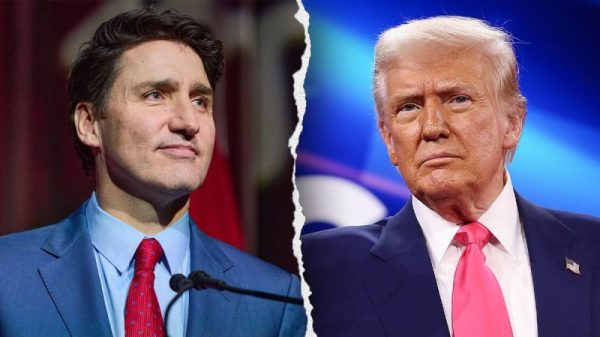The gold price has hit record levels in 2024, leaving investors wondering just how high it can go.
During a recent webinar presented by the Mining Network, host Simon Catt, asset management director at Arlington Group, was joined by a group of industry veterans who gave their thoughts on where gold and silver may be going.
The group was comprised of Eric Sprott, founder of Sprott Securities and Sprott Asset Management; Franco-Nevada (TSX:FNV,NYSE:FNV) founder and Chair Emeritus Pierre Lassonde; Ned Naylor-Leyland, gold and silver fund manager at Jupiter Asset Management; Luke Gromen, founder of macroeconomic research firm Forest for the Trees; and Michael Oliver, founder and CEO of technical research firm Momentum Structural Analysis.
Read on for an overview about what they said about the future of the yellow and white metals.
Historic precedent for gold price gains
2023 saw the gold price trading between support and resistance as investors kept to the sidelines and favored the high yields and safety of the bond market and interest-bearing assets.
This year, markets are on edge due a slew of factors, including a volatile macroeconomic situation, spiking sovereign debt, grinding conflicts in Eastern Europe and the Middle East and an upcoming election in the US that is all but guaranteed to create deeper divisions within the world’s largest economy.
Oliver sees a situation starting to play out that is reminiscent of the gold bull markets that ran from 1979 to 1980 and 2010 to 2011. “I think we have the most interesting set of dynamics for this year that we’ve ever seen in markets compressed into a short-term period of time,” he said during the panel.
Like today, these were periods of high volatility. The end of the 1970s brought staggering growth in inflation, and central banks responded with skyrocketing interest rates; meanwhile, 2010 saw interest rates fall to near 0 percent on the back of a recession caused by an imploding housing market in the US.
In both cases, investors looked to hedge their portfolios with gold and drove the price to new highs.
Watch the full Gold: The Real Thing panel.
What came after? Oliver said that both gold and silver prices saw huge gains. “During those times not only did gold and silver go vertical, but silver outpaced gold by double and triple,’ he noted.
He believes a similar situation is setting up in 2024 with instability in the financial system, geopolitical uncertainty and a reverberating sense of nervousness in the markets.
Lassonde also looked back to the 1970s, recalling an inflationary environment that bears similarities to today. He pointed to increasing US debt, with a US$2 trillion per year deficit and policies that are injecting more cash into the market.
“They’re printing money, and when you’re printing money, you’re going to create inflation and it’s going to be very, very sticky,” he told listeners during the online event.
De-dollarization boosting global gold demand
Gromen intimated that America’s high debt load is reducing confidence in the US dollar as a global reserve currency and causing a reduction in foreign holdings. Instead, central banks are moving to gold as a means to diversify.
He pointed to China, which has been making bulk purchases of gold as a matter of national security as it attempts to limit its use of the US dollar and deals with a global distrust of the yuan for trading commodities like oil.
“Yuan oil demand is turning gold back into an oil currency, and on an annual dollar production basis the oil market is 12 to 15 times the size of the physical gold market,” Gromen said.
This sentiment was echoed by Lassonde when he spoke about the future of the greenback, noting that gold isn’t needed when the dollar performs its function as a reserve currency.
“But when it doesn’t, that’s when gold usually shines,” he said.
Lassonde also suggested that actions from the US have effectively weaponized the dollar.
Against that backdrop, some countries, like those in the BRICS bloc, have become frustrated with the US and are pursuing their own system. Lassonde sees this manifesting in strong central bank buying of gold, noting that more than 1,200 metric tons were accumulated in 2023, representing over a third of the 3,400 metric tons produced.
He also pointed to another entity in the over-the-counter market that has been driving the gold price, but said he doesn’t think it’s central banks. Simply calling it a ‘whale,’ Lassonde said he’s seen moves in the market where calls have been bought at higher prices. “Is it Chinese interests that are doing this? I don’t know. Nobody knows. I’ve asked around, nobody knows, but it is a very interesting time in the gold space right now,” he said.
Is silver due to follow gold higher?
While there has been a lot of media attention surrounding gold as price records continue to be set, silver too has benefited, and may be poised for an even greater surge. As a monetary metal, silver is influenced by the same macroeconomic and geopolitical variables as gold, but it has an additional industrial component that is spiking demand.
While Gromen still sees silver as a monetary metal for the masses, he doesn’t see it being useful to central banks that are looking to deleverage their debt. He said if that happened it would drive the price of the white metal in ways that would ultimately collapse the economy, likening it to oil and copper.
“If you take oil up from US$80 a barrel to US$400, the global bond market is going to collapse, and the bottom half of the global population is going to starve. If you did so with corn, if you did so with wheat, if you did so with copper — same sort of dynamic. Those are very useful commodities,” Gromen said.
While bullish on silver, Sprott believes the market is manipulated and the price is suppressed.
“I look at what happened on the last day of March, and the price of silver looked like it wanted to go when it was being suppressed … I’m assuming that the guys who are short the 800 million ounces of silver on the COMEX didn’t want the price to explode for quarter end, which of course is very important to banking institutions. Needless to say, from that day on silver has basically gone straight up,” Sprott said. Silver surged above US$30 per ounce on May 17.
Sprott said that according to the Silver Institute, demand for silver is outstripping supply by 200 million ounces. A considerable portion of that demand is silver destined for India, which purchased 76 million ounces in February, representing nearly all the production of silver for the month, and another 32 million ounces in March.
In addition to Indian demand, Sprott spoke about how there is a push in China to invest in silver. “China has come out in advertisements on TV suggesting their citizens should buy silver rather than gold. Now, that is a rather dramatic thing when you’re thinking that 1.4 billion people over there are all buying silver when there is already a shortage,” he said.
Naylor-Leyland also touched on the theme of silver market tightness during the webinar, saying the market imbalance is favoring a rise in price based solely on industrial demand for the white metal.
He also suggested that a positive shift in investment could send the silver price soaring. “I think that the market at some point will have to understand that the silver is going to come from somewhere, and then I see that as the best, most obvious way that investors can benefit from a big rewriting of the mining equity space,” he said.
How high can gold and silver prices go?
Overall, the panelists see variables aligning to support a surge in prices for monetary metals.
Lassonde believes one possible outcome is the ratio between gold and the Dow Jones Industrial Average (INDEXDJX:.DJI) becoming 1:1. Citing historical events to support this claim, he noted that it’s happened twice over the past 120 years.
The first instance was after the Great Depression, when the Dow lost 90 percent of its value between 1929 and 1934, going from 380 points to 36, matching the price of gold at the time.
The second was from 1979 to 1980. Lassonde explained that after it peaked at over 1,000 points in 1966, the Dow retreated to around 600 points by the mid-1970s. This came alongside the end of the gold standard in 1971, and the price of gold moved higher. By 1980, the Dow had recovered to 819 points and gold had soared to US$800 per ounce.
“Do I believe it’s going to go back to 1:1? Maybe, but maybe at that point the Dow is not 37,000, it may be half of that. Okay, so if you say it goes back to 2:1 and the Dow stays where it is, that’s still close to US$19,000 gold. And if the Dow goes back down to 20,000 and it goes to 1:1, you’re still looking at US$20,000 gold,” he commented.
Lassonde noted that the gap between the last two times for gold to reach parity with the Dow was 46 years, which he thinks would be a reasonable timeframe again — it could then occur in 2026 or 2027. On a more immediate timeline, he said the gold price could easily reach US$3,200 within the next 12 months.
He’s also predicting that the gold-silver ratio will go to 70:1, taking silver to US$40 over the next 18 months.
Though Lassonde’s predictions may seem high, he wasn’t alone on the panel. Pointing to previous shifts from bear to bull markets, Oliver suggested a seven to eightfold price movement isn’t out of line, which would lead to US$8,000 gold. He also suggested that silver could potentially rise to above US$200 in those circumstances.
Gromen anticipates similar gains, calling for a near-term gold price of US$3,000. He thinks it will move quickly and will rise more significantly in the longer term, basing his call on the gold price as a percent of US foreign-held treasuries.
From 1970 to 1989, the percentage was never less than 20 and averaged 40 percent; however, when the global economy was concerned about the US dollar in the late 1970s, it grew to 135 percent. Following the collapse of the Soviet Union, it declined to 5 percent and today it’s at 7 percent. Gromen said the low ratio, along with the debt crisis, suggests a three time price move to get to the historical low of 20 percent and six times to 40 percent.
“US$7,500 on the low end, and in a real dollar crisis you could go 100 percent, right? So you’d have to go up 10 times, 15 times,’ he explained, adding that his base case is US$7,000 to US$10,000 at the end of the cycle.
For his part, Naylor-Leyland opted not to provide a price prediction for gold, instead suggesting it is more about what happens with the US dollar and treasuries, and that gold is more useful when it comes to measuring the strength of local currencies. However, he did note that he could see pullbacks in the next 12 months.
When it comes to silver, Naylor-Leyland said he sees a narrowing gap in the gold-silver ratio. He predicts it will drop below 70:1, allowing the silver price to climb above the US$30 level.
Investor takeaway
While gold price predictions of US$7,500, US$10,000 or even US$20,000 might seem like wild theories, it’s important to recognize that they are coming from respected industry veterans.
When asked for his opinion, Sprott said he could see them all playing out. However, he emphasized that investors can make money without gold making the incredible gains suggested by Lassonde, Oliver and Gromen.
“For people to profit immensely from where we are, I mean if it just went to US$3,000 I’m sure the gold stocks would probably go up 100 percent. So that’s probably more what I’d like to leave on the table — that you don’t need to go to any of those levels to be a very successful investor in the precious metals area,” he said.
Securities Disclosure: I, Dean Belder, hold no direct investment interest in any company mentioned in this article.






































